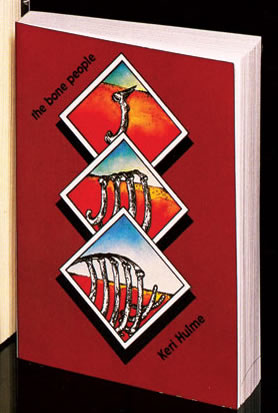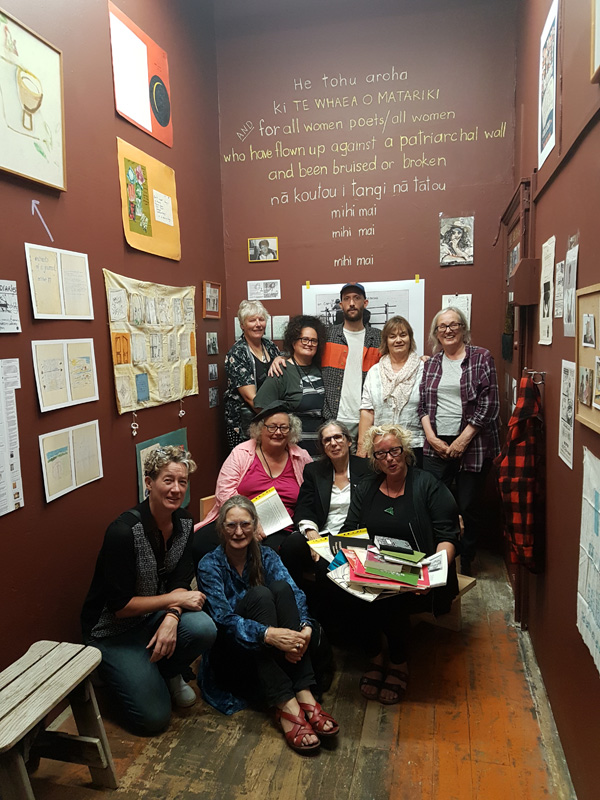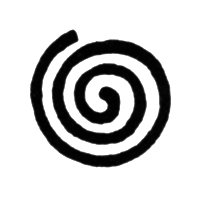This essay written by Marian Evans was first published in Women Together: a History of Women's Organisations in New Zealand in 1993. It was updated by Marian Evans in 2019.
1975 – 1993
Heather McPherson, Paulette Barr, Alison Mitchell and Kathryn Algie founded Spiral from Christchurch in 1975, to produce a women's literary and arts journal of the same name. The first Spiral collective was:
. . .much more structured in old ways than any later collective . . . I worked with the material we received – that it didn't reflect our own reality didn't bother me too much, it was the idea of women working together for women's voices to be heard, positively, that was the aim, and the amalgam of arts . . .[1]
Herstory Press in Wellington printed the first issue, Spiral 1, which appeared in 1976. Spiral then became a floating imprint used by a variety of feminist groups. Three more issues of the journal were produced between 1977 and 1979 by a series of Christchurch collectives, many of whose members were also involved in other women's art and literature activities, in particular the women's art environment created at the Canterbury Society of Arts during the 1977 United Women's Convention. In 1982 a Wellington collective connected with The Women's Gallery, Kidsarus 2 and Wellington Women's Refuge produced Spiral 5, and in 1985 the Colville Women's Writing Co-operative produced Spiral 6, subtitled of women and land.
The Spiral 5 collective members who had worked with Kidsarus 2 knew that those who made decisions in established publishing structures resisted commitment to work which reflected realities unfamiliar or unattractive to them, especially those of Māori and other women, who were not strongly represented among the decision makers. Furthermore, the relatively straightforward process of publishing was given a mystique, and represented as something only 'professional' publishers could do successfully.
These members decided to develop Spiral into a book publisher of last resort. This involved publishing manuscripts which they believed in and no one else wanted to publish. They also decided to pass on what they had learned about the publishing process to other women.

Alexander Turnbull Library, Eph-C-BOOK-AWARDS-1984-02.
The cover of the bone people, published by Spiral in 1984, was designed by the author, Keri Hulme. In 1985 this novel became the first by a New Zealand author to win the Booker Prize.
Seven books resulted between 1982 and 1987, and sold well. [2] When Spiral accepted for publication two books by Māori women writers [3] who had been unable to find publishers, it invited two Māori women to become members of a three-woman collective to publish them. Both accepted. The demanding experiences that followed generated both difficulties and joy for collective members and others. Women connected with Spiral, Haeata, The Women's Gallery and Kidsarus 2 who were not involved in decision-making about the books gave many hours of work, including proof-reading, pasting up and fundraising. They also organised and catered for Spiral's then unconventional book launches. Some women donated substantial sums of money.
As mainstream publishing attitudes changed, Spiral had less to do; the members also felt more confident advising women to try publishing their own work and that of women close to them. One Auckland group used the Spiral imprint in 1985 to publish their own poems.
Collective members did, however, want to extend their networks among indigenous women, feminists and lesbians overseas, and achieved this through attendance at feminist book fairs. With assistance from Christine Cole Catley, the group organised a visit by a local writer and supplied books from many publishers for the first International Feminist Book Fair in London in 1984. A Spiral group of seven women with many more books were at the next fair, in Oslo in 1986, and two collective members organised a stand at the Barcelona fair in 1990, with Carole Beu.
Spiral 7: A Collection of Lesbian Art and Writing was published from Dunedin in 1992, with McPherson as one of the editors. At that point Spiral's future depended on whether women whose work might otherwise remain unpublished, or unpublished in a feminist context, wanted to use it as an imprint.
Marian Evans
1993 – 2018
After issue 7 of Spiral was published in 1992, Spiral and its umbrella organisation, The Women’s Gallery, added more files to their comprehensive archives in the Alexander Turnbull Library (ATL), then paused. The next book appeared in 1999, when Sue Fitchett and Jane Zusters used the Spiral imprint to publish Charts & Soundings: Some Small Navigation Aids. [4]
The availability of digital video cameras that generated broadcast quality images inspired a major Spiral video project, Getting Free (1997–2009), about resilience following violation, including the violations of colonization; this was supported by many generous funding bodies and moderated by protocols developed by Bridie Lonie and Marian Evans. Participants in the Getting Free video project, led by Marian and often based at Gender and Women’s Studies at Victoria University, included Galvan Macnamara (1941–2004) with a feature-length documentary called Sister Galvan [5], Irihapeti Ramsden (1946–2003), Allie Eagle and her mother Lorna Mitchell (1923–2009), matakite Wai Turoa Morgan (1941–2017), and others. Juanita Ketchel (1946–2013), with Bridie Lonie, later developed a Dunedin-based Getting Free oral history project.
A Spiral group also organised Mahi Ata Mahi Ahua: Women’s Work in Film (named by Keri Hulme) at Wellington’s City Gallery on 18–21 September 2003, showing 50 short films, documentaries and experimental works by New Zealand women directors.
Spiral paused again, until Heather McPherson (1942–2017) became seriously ill. Because of this and increasing demand for accurate information about the organisation’s history, an online publication called Spiral Collectives was established in early 2016, to which Heather contributed two new articles. The site brought together significant Spiral and Women’s Gallery texts and updated histories of key members and activities, using information from the ATL collections and elsewhere. Some articles highlighted connections between participants in Spiral and the Women’s Gallery, and their work in other feminist groups; these included an autobiographical essay by a Women’s Gallery photographer, Mary Bailey, about the photograph she took for Herstory Press’s classic ‘Momma Don’t Allow Me To Whistle’ poster; [6] and an article about Auckland Women’s Community Video, whose members Kanya (Carole) Stewart and Nancy Peterson had documented the opening of the Women’s Gallery. [7] Others came from women of later generations.
In early 2018, a group of former Spiral members – Janet Charman, Lynne Ciochetto and Marian Evans – produced Heather McPherson’s fifth poetry collection, This Joyous, Chaotic Place: Garden Poems [8]. This was published in association with a Suffrage 125 project, This Joyous, Chaotic Place: He Waiata Tangi-ā-Tahu, [9] an exhibition about Heather and her peers at Mokopōpaki, an Auckland dealer gallery with Māori values at its centre. It generated three catalogues, including a major publication with contributions from Spiral associates Allie Eagle, Cushla Parekowhai, Heather herself, Margery Blackman, Marian Evans and Tiffany Thornley. According to Francis McWhannell, this exhibition ‘blast[ed] open the archives’. [10] It also resulted in some key works entering a public collection.

Sriwhana Spong, courtesy of Jane Zusters
This Joyous, Chaotic Place: He Waiata Tangi-ā-Tahu exhibition opening at Mokopōpaki gallery, Auckland, 2018. Back, l-r: Jane Zusters, Dr. P., Jacob Raniera, Dianne Rereina Potaka-Wade, Marian Evans; middle, l-r: Allie Eagle, Adrienne Martyn, Tilly Lloyd; front, l-r: Annie Mein, Bridie Lonie.
At the same time, interest in Heather’s work and Spiral grew among women who could have been Heather’s grand-daughters. For instance, poet and academic Emer Lyons, who had reviewed This Joyous, Chaotic Place for Landfall, [11] undertook to edit Heather’s erotic poems for publication by Spiral; and artist and critic Jaimee Stockman-Young incorporated some of Heather’s poems in a performance for a Berlin conference.
Later in 2018, 35 years after the bone people was first published, followed by various translations, Spiral assisted Automática Editorial to prepare a Spanish edition.
The archives continued to grow, for example when Miriama Evans (1942–2018) also became terminally ill, and wanted the Spiral documents she had held to be added to them. From 2018, a Spiral/Women’s Gallery group attempted to complete the archives, to make them as open as possible to researchers, and to devolve responsibility for them to representatives of the next generation. This required Bridie Lonie and Marian Evans, guided by Barry Barclay’s philosophy described in Mana Tuturu, [12] to develop further protocols to take account of changing conditions and the need to protect individuals and their families from hurt, in the ongoing use of this challenging combination of personal and organisational documents.
Spiral Collectives continued to provide a multigenerational platform for further research, writing and images.
Marian Evans
Notes
[1] Heather McPherson in Evans et al., 1988, p. 40.
[2] In order of publication, they were: Heather McPherson, A Figurehead: A Face, Wellington, 1982; J. C. Sturm, The House of the Talking Cat, Wellington, 1983; Keri Hulme, the bone people, Wellington, 1984; Wahine Kaituhi: Women Writers of Aotearoa New Zealand, Wellington, 1985; Marina Bachmann, Janet Charman, Sue Fitchert, Drawing Together, Auckland, 1985; Hilary Baxter, The Other Side of Dawn, Wellington, 1987; Saj, Amazon Songs, Wellington, 1987.
[3] J. C. Sturm, 1983; Keri Hulme, 1984.
[4] Fitchett and Zusters, 1999.
[5] Evans, 2003.
[6] Bailey, Mary, ‘Momma Don’t Allow Me to Whistle’, Spiral Collectives, 4 Jan. 2017, https://medium.com/spiral-collectives/momma-dont-allow-me-to-whistle-b0a8e608a0b0
[7] ‘Auckland Women’s Community Video’, 30 Nov. 2017, Women’s Film Activists, https://medium.com/women-s-film-activists/auckland-womens-community-video-2beebdf6da09
[8] McPherson, 2018.
[9] Mokopōpaki, This Joyous, Chaotic Place: He Waiata Tangi-ā-Tahu, 1 March–14 April 2018. See also ‘Coming Soon!’, Spiral Collectives, 22 Dec. 2017, https://medium.com/spiral-collectives/coming-soon-this-joyous-chaotic-place-d4d0c7ffe7b1 and Arekahānara, ‘Images from This Joyous, Chaotic Place’, Mokopōpaki, 2018, https://gallery.mokopopaki.co.nz/tagged/thisjoyouschaoticplace
[10] McWhannell, 2018.
[11] Lyons, Emer, ‘Gardens and Gloom’, Landfall Review Online, 1 December 2018, https://landfallreview.com/gardens-and-gloom/
[12] Barclay, B., Mana Tuturu: Maori Treasures and Intellectual Property Rights, Auckland University Press, Auckland, 2005.
Unpublished sources
Spiral, The Women's Gallery, Kidsarus and Kidsarus 2 collections, 1975–92, ATL
Published sources
Auckland Women's Community Video and Women's Gallery, Interview, Anna Keir, Marian Evans, Nancy Peterson, 26 Harris Street, Wellington (video, 20 mins), 1980, https://www.youtube.com/watch?v=-UZOLx83ADk
Collard, Judith, ‘Spiral Women: Locating Lesbian Activism in New Zealand Feminist Art, 1975–1992’, Journal of the History of Sexuality, Vol. 15 No. 2, 2006, 292–320
Evans, Marian, ‘Sister Galvan’, posted on Wellywood Woman [n.d.], https://wellywoodwoman.blogspot.com/p/sister-galvan.html
Evans, Marian, ‘J. C. Sturm, 1980’, video interview and documents, Spiral, Women’s Gallery & Auckland Women's Community Video, Wellington, 1980/2018, posted on Spiral Collectives, 13 March 2019, https://medium.com/spiral-collectives/jacquie-sturm-1980-2bae61cae4fb
Evans, Marian, Sister Galvan, Spiral (film, 89 mins), 2003
Evans, Marian, ‘Keri Hulme’s the bone people’, Wellywood Woman, 2010, reposted on Spiral Collectives, 18 Jan. 2016, https://medium.com/spiral-collectives/the-bone-people-f73c01ce7684
Evans, Marian, ‘In the Beginning, There Was Heather’, Spiral Collectives, 31 May 2016, https://medium.com/spiral-collectives/in-the-beginning-there-was-heather-d2ebbf4dd63c
Evans, Marian, ‘Spiral’s Interview Protocols’, Spiral Collectives, 28 April 2019, https://medium.com/spiral-collectives/spirals-interview-protocols-a34f06d2d6a1
Evans, Marian, Bridie Lonie, and Tilly Lloyd (eds), A Women's Picture Book: 25 Women Artists of Aotearoa (New Zealand), GP Books, Wellington, 1988
Evans, Miriama, ‘Politics and Māori Literature’, Landfall, Vol. 39 No. 1, March 1985, 40–44, posted with permission and updated on Spiral Collectives, 24 Oct. 2016, https://medium.com/spiral-collectives/politics-and-maori-literature-c8e8feaff490
Fitchett, Sue and Jane Zusters, Charts & Soundings: Some Small Navigation Aids, Spiral with Island Bridge, Auckland, 1999
Kaa, Keri, ‘Patricia Grace: Aspects of Her Stories in Waiariki & The Dream Sleepers’, Spiral 5, 1982, posted on Spiral Collectives, 3 July 2016, https://medium.com/spiral-collectives/patricia-grace-aspects-of-her-stories-in-waiariki-dream-sleepers-c5e8d824c806
Kaa, Keri, ’A Letter to My Mother’, Spiral 5, 1982, posted on Spiral Collectives, 30 Dec. 2016, https://medium.com/spiral-collectives/a-letter-to-my-mother-97d7b67caac
Ketchel, Juanita, Getting Free Oral History Project, ATL, OHColl-0718
Ketchel, Juanita, ‘Getting Free: Oral Histories of Violence, Resilience and Recovery’, in A. Green and M. Hutching (eds), Remembering: Writing Oral History, Auckland University Press, Auckland, 2005, pp. 90–103
McPherson, Heather, ‘Spiral’, Spiral Collectives, 13 Oct. 2016, https://medium.com/spiral-collectives/spiral-7a36f618b9a0
McPherson, Heather, ‘Travelling With Arapera [Blank]’, Spiral Collectives, 27 Oct. 2016, https://medium.com/spiral-collectives/travelling-with-arapera-702069d32377
McPherson, Heather, This Joyous, Chaotic Place: Garden Poems, Spiral, Wellington, 2018
McWhannell, Francis, ‘The Unmissables: Four Exhibitions to See in March’, Pantograph Punch, 2 March 2018, https://www.pantograph-punch.com/post/unmissables-march
Mokopōpaki, This Joyous, Chaotic Place: He Waiata-Tangi-ā-Tahu (three exhibition catalogues), Mokopōpaki, Auckland, 2018–2019
Parekowhai, Cushla, ‘Kōrero Ki Taku Tuakana: Conversation With My Big Sister, Merata Mita and Mauri’ [interview], Illusions, No. 9, December, 1988 (Victoria University of Wellington). Edited and posted on Spiral Collectives, 14 March 2016, https://medium.com/spiral-collectives/kōrero-ki-taku-tuakana-conversation-with-my-big-sister-d17c22fcf3fe
Parekowhai, Cushla, Allie Eagle and Heather McPherson, ‘Have You Heard of Artemisia?’, Spiral Collectives, 18 June 2016, https://medium.com/spiral-collectives/have-you-heard-of-artemisia-7b9f0fe2862a
Rankine, Jenny, ‘Lesbian/Feminist Heritage Exhibition’, Lesbian News, Hui-Tanuru/February 2018, https://lesbianaotearoa.wordpress.com/news/hui-tanguru-february-2018/
Spiral 1–7, 1976–92
Spiral Collectives: An Open Research Project, 2016– , https://medium.com/spiral-collectives
Stockman-Young, Jaimee, ‘Honour & History: This Joyous, Chaotic Place’, Art New Zealand, No. 166, Winter 2018, 80–83


Community contributions